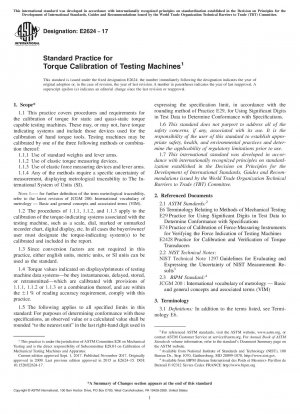ASTM E2624-17
Standard Practice for Torque Calibration of Testing Machines
- Standard No.
- ASTM E2624-17
- Release Date
- 2017
- Published By
- American Society for Testing and Materials (ASTM)
- Latest
- ASTM E2624-17
- Scope
- 1.1 This practice covers procedures and requirements for the calibration of torque for static and quasi-static torque capable testing machines. These may, or may not, have torque indicating systems and include those devices used for the calibration of hand torque tools. Testing machines may be calibrated by one of the three following methods or combination thereof: 1.1.1 Use of standard weights and lever arms. 1.1.2 Use of elastic torque measuring devices. 1.1.3 Use of elastic force measuring devices and lever arms. 1.1.4 Any of the methods require a specific uncertainty of measurement, displaying metrological traceability to The International System of Units (SI). NOTE 1—– for further definition of the term metrological traceability, refer to the latest revision of JCGM 200: International vocabulary of metrology — Basic and general concepts and associated terms (VIM). 1.2 The procedures of 1.1.1, 1.1.2, and 1.1.3 apply to the calibration of the torque-indicating systems associated with the testing machine, such as a scale, dial, marked or unmarked recorder chart, digital display, etc. In all cases the buyer/owner/ user must designate the torque-indicating system(s) to be calibrated and included in the report. 1.3 Since conversion factors are not required in this practice, either english units, metric units, or SI units can be used as the standard. 1.4 Torque values indicated on displays/printouts of testing machine data systems—be they instantaneous, delayed, stored, or retransmitted—which are calibrated with provisions of 1.1.1, 1.1.2 or 1.1.3 or a combination thereof, and are within the 61 % of reading accuracy requirement, comply with this practice. 1.5 The following applies to all specified limits in this standard: For purposes of determining conformance with these specifications, an observed value or a calculated value shall be rounded “to the nearest unit” in the last right-hand digit used in expressing the specification limit, in accordance with the rounding method of Practice E29, for Using Significant Digits in Test Data to Determine Conformance with Specifications. 1.6 This standard does not purport to address all of the safety concerns, if any, associated with its use. It is the responsibility of the user of this standard to establish appropriate safety, health, and environmental practices and determine the applicability of regulatory limitations prior to use. 1.7 This international standard was developed in accordance with internationally recognized principles on standardization established in the Decision on Principles for the Development of International Standards, Guides and Recommendations issued by the World Trade Organization Technical Barriers to Trade (TBT) Committee.
ASTM E2624-17 Referenced Document
- ASTM E2428 Standard Practice for Calibration and Verification of Elastic Torque Measurement Standards*, 2022-11-01 Update
- ASTM E29 Standard Practice for Using Significant Digits in Test Data to Determine Conformance with Specifications
- ASTM E6 Standard Terminology Relating to Methods of Mechanical Testing
- ASTM E74 Standard Practices for Calibration and Verification for Force-Measuring Instruments*, 2018-02-01 Update
ASTM E2624-17 history
- 2017 ASTM E2624-17 Standard Practice for Torque Calibration of Testing Machines
- 2015 ASTM E2624-15 Standard Practice for Torque Calibration of Testing Machines
- 2009 ASTM E2624-09 Standard Practice for Torque Calibration of Testing Machines and Devices
